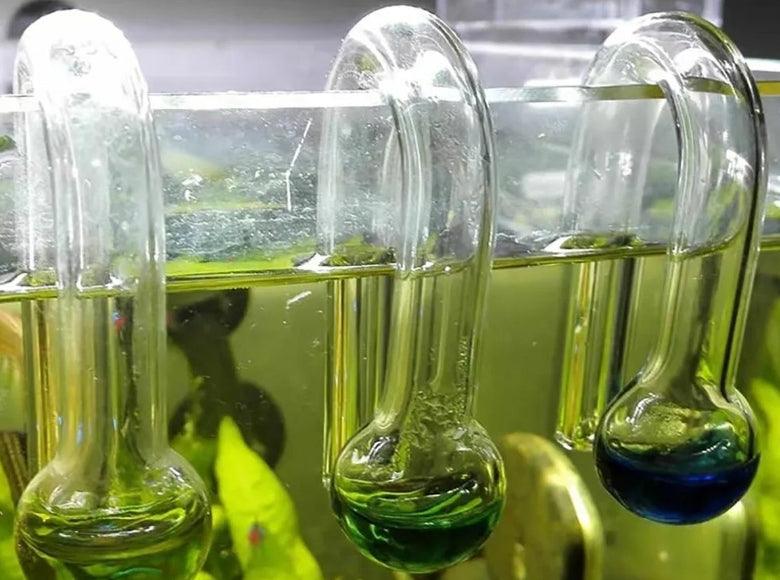For aquarium enthusiasts, maintaining appropriate levels of carbon dioxide (CO2) in a tank is crucial for the health of aquatic plants. CO2 is not only a key element for photosynthesis but also affects the pH levels of the water, impacting the entire aquarium ecosystem. In this article, we will discuss the importance of CO2 monitoring and recommend some excellent products to help you better manage your aquarium.
Why is CO2 Monitoring Important?
-
Promotes Plant Growth: Carbon dioxide is essential for photosynthesis. Adequate CO2 supply significantly promotes the growth of aquatic plants, making them denser and healthier. Plants use CO2, light, and water to produce oxygen and glucose, which are vital for their growth and energy. Without sufficient CO2, plants can become weak and stunted, leading to a less vibrant aquarium.
-
Balances pH Levels: Dissolved CO2 forms carbonic acid, which influences the water's pH levels. Proper CO2 concentration helps maintain a stable pH, preventing stress on fish and other aquatic life caused by pH fluctuations. A stable pH environment is crucial for the well-being of all aquarium inhabitants. Fluctuating pH levels can lead to stress and health issues for fish and invertebrates.
-
Prevents Algae Overgrowth: Efficient CO2 management enhances the competitiveness of plants, thereby inhibiting excessive algae growth and keeping the aquarium clean and aesthetically pleasing. Algae thrive in environments with excess nutrients and light but can be controlled by ensuring that aquatic plants outcompete them for these resources. Proper CO2 levels enable plants to grow more robustly and dominate the ecosystem, leaving less room for algae to proliferate.
-
Enhances Aquarium Aesthetics: A well-maintained CO2 level ensures that aquatic plants thrive, creating a lush, green, and visually appealing aquarium. Healthy plants also provide shelter and breeding grounds for fish and other aquatic creatures, contributing to a more natural and harmonious environment.
-
Supports Overall Ecosystem Health: The presence of healthy, growing plants supported by adequate CO2 levels contributes to the overall health of the aquarium ecosystem. Plants help oxygenate the water, absorb harmful toxins, and provide a habitat for beneficial microorganisms. This holistic approach to aquarium management leads to a more stable and sustainable environment for all inhabitants.



Product Recommendations
The Stainless Steel CO2 Diffuser distributes CO2 evenly throughout the aquarium via tiny bubbles, ensuring plants can fully absorb it. Made from high-quality stainless steel, it is corrosion-resistant and easy to clean.
The CO2 Carbon Dioxide Refiner precisely controls the release of CO2, ensuring stable CO2 concentration in the aquarium. It features advanced design and easy operation, suitable for aquariums of all sizes.
The CO2 Drop Checker monitors the CO2 concentration in the aquarium by displaying color changes, helping you understand the CO2 status in real-time and make necessary adjustments.
How to Use These Products?
-
Install the CO2 Diffuser: Place it in an appropriate location within the aquarium, connect the CO2 cylinder, and adjust the bubble rate to distribute CO2 evenly.
-
Use the CO2 Refiner: Set the appropriate CO2 release rate based on the aquarium size and plant needs. Regularly check the device's operation to ensure it functions correctly.
-
Monitor CO2 Levels: Place the CO2 Drop Checker in the aquarium, observe its color changes, and adjust the CO2 supply accordingly to maintain optimal CO2 levels.
Conclusion
Maintaining appropriate CO2 levels is essential for a healthy aquarium. By using efficient CO2 monitoring and management devices like the Stainless Steel CO2 Diffuser, CO2 Carbon Dioxide Refiner, and CO2 Drop Checker, you can better care for your aquatic plants, maintain stable water quality, and create a healthy, beautiful aquarium ecosystem.
We hope this article helps you better understand and manage the CO2 levels in your aquarium. If you have any questions or need more information, please feel free to visit the Petfection Corner website.

